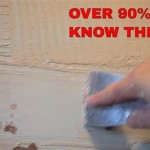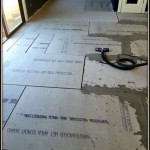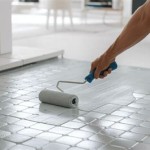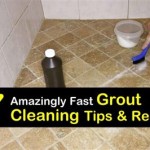What Can I Use To Get Dried Grout Off Tiles and Physical Questions
Dried grout on tiles is a common problem encountered during and after tiling projects. Removing it effectively without damaging the tile surface requires careful selection of cleaning agents and techniques. Understanding the composition of grout and the nature of different tile materials is crucial in choosing the right approach. This article examines various methods and products available for removing dried grout, addressing common physical questions related to the process, such as pressure application and potential tile damage.
Grout, typically a mixture of cement, sand, and polymers, hardens as it dries, forming a strong bond between tiles. The type of grout—cement-based, epoxy, or urethane—influences the cleaning method. Cement-based grout is porous and susceptible to absorbing stains, while epoxy and urethane grouts are more resistant to staining and are generally easier to clean. Tile materials also vary widely, including ceramic, porcelain, glass, natural stone (e.g., marble, granite), and others. Each material possesses different properties that affect its susceptibility to scratching, etching, or staining from cleaning agents.
Understanding the Composition of Dried Grout
The difficulty in removing dried grout stems from its chemical and physical properties. Cement-based grout, the most common type, contains cement particles that hydrate during the curing process, forming a hard, insoluble matrix. This matrix is further strengthened by the inclusion of additives and polymers. Epoxy grouts, on the other hand, are thermosetting polymers that exhibit superior chemical resistance and impermeability. Urethane grouts are a hybrid of the two, combining the flexibility of polymers with the durability of cement.
Dried grout adheres to tile surfaces through a combination of mechanical interlocking and chemical bonding. Mechanical interlocking occurs as the grout fills the microscopic pores and irregularities on the tile surface. Chemical bonding arises from the interaction between the grout components and the tile material. The strength of these bonds makes it challenging to remove dried grout without potentially damaging the tile.
Factors such as the age of the dried grout, the degree of contamination (e.g., presence of dirt, mineral deposits), and the type of tile material influence the effectiveness of different cleaning methods. Freshly dried grout is generally easier to remove than grout that has been in place for an extended period. Porous tiles, such as natural stone, may absorb grout residue, making it more difficult to extract.
Chemical Cleaning Methods for Removing Dried Grout
Chemical cleaning methods involve the use of acidic or alkaline solutions to dissolve or soften the dried grout. Acidic cleaners are particularly effective at dissolving cement-based grout, while alkaline cleaners are better suited for removing organic stains and grease. However, the choice of chemical cleaner depends on the type of grout and the tile material.
Muriatic acid (hydrochloric acid) is a strong acid commonly used to remove stubborn grout residue. However, it is highly corrosive and should be used with extreme caution. Proper ventilation, protective gear (gloves, eye protection), and neutralization with baking soda are essential when working with muriatic acid. Muriatic acid can etch or damage certain tile materials, such as natural stone and glazed ceramic tiles, so it is crucial to test it on an inconspicuous area first.
Sulfamic acid is a milder alternative to muriatic acid that is less likely to damage tile surfaces. It is available in powder form and can be dissolved in water to create a cleaning solution. Sulfamic acid is effective at removing cement-based grout residue, mineral deposits, and rust stains. However, it may not be as effective on epoxy or urethane grouts.
Phosphoric acid is another acid-based cleaner that can be used to remove grout haze and mineral deposits. It is generally safer to use than muriatic acid and less likely to damage tile surfaces. Phosphoric acid is commonly found in commercially available grout haze removers.
Alkaline cleaners, such as trisodium phosphate (TSP) or sodium carbonate (soda ash), can be used to remove organic stains and grease from grout. However, they are not as effective at dissolving cement-based grout as acidic cleaners. Alkaline cleaners can also damage certain tile materials, such as aluminum and painted surfaces, so it is important to test them on an inconspicuous area first.
When using any chemical cleaner, it is crucial to follow the manufacturer's instructions carefully. Always test the cleaner on an inconspicuous area of the tile to ensure that it does not cause any damage or discoloration. Apply the cleaner to the grout, allow it to dwell for the recommended time, and then scrub the grout with a brush or sponge. Rinse the area thoroughly with water to remove any remaining cleaner residue.
Physical and Mechanical Methods for Removing Dried Grout
Physical and mechanical methods involve using tools and techniques to physically remove the dried grout from the tile surface. These methods are often used in conjunction with chemical cleaning methods to achieve optimal results.
Scrapers and grout removal tools are designed to remove dried grout without damaging the tile. These tools typically have a sharp blade or edge that can be used to scrape away the grout. The angle and pressure applied when using these tools are important considerations. Applying too much pressure can scratch or chip the tile surface, while applying too little pressure may not be effective at removing the grout.
Oscillating multi-tools with grout removal attachments are power tools that can be used to remove dried grout quickly and efficiently. These tools use a vibrating motion to loosen and remove the grout. The speed and pressure applied when using these tools should be carefully controlled to avoid damaging the tile surface. Using the correct blade angle and keeping the tool moving can minimize damage.
Steam cleaners can be used to soften and loosen dried grout. The high-temperature steam penetrates the grout, making it easier to remove with a brush or sponge. Steam cleaning is a non-chemical method that is safe for most tile materials. However, it may not be effective on heavily stained or deeply embedded grout.
Abrasive pads or brushes can be used to scrub away dried grout. The abrasiveness of the pad or brush should be chosen based on the type of tile material. Soft pads or brushes should be used on delicate tiles, such as natural stone or glass, while more abrasive pads or brushes can be used on durable tiles, such as porcelain or ceramic. Care must be taken to avoid scratching the tile surface.
When using any physical or mechanical method, it is important to work carefully and methodically. Start with a small area and gradually work your way across the entire surface. Regularly inspect the tile surface for any signs of damage. If you notice any scratches or chips, reduce the pressure or switch to a less abrasive tool.
Physical Questions Regarding Grout Removal
Several physical questions arise when considering grout removal. The amount of pressure applied, the angle of the tool, and the potential for tile damage are all significant concerns.
How much pressure should one apply while scraping grout? The optimal pressure depends on the type of grout, the tile material, and the tool being used. Generally, start with light pressure and gradually increase it until the grout begins to loosen. Excessive pressure can damage the tile's surface or edges. For instance, when using a manual grout removal tool, focus on maintaining a consistent angle and using short, controlled strokes. With power tools, let the tool do the work, applying minimal downward pressure.
At what angle should a scraping tool be held? The angle of the scraping tool is crucial for effective grout removal and minimizing tile damage. A shallow angle (almost parallel to the tile surface) is generally preferred as it reduces the risk of chipping or scratching the tile. However, a slightly steeper angle might be necessary to effectively engage the grout. Experiment on a small, inconspicuous area to determine the optimal angle for the specific grout and tile combination.
What are the chances of damaging the tiles during grout removal? The risk of tile damage depends on several factors, including the type of grout, the hardness of the tile, the technique used, and the tool employed. Softer tiles, such as natural stone, are more susceptible to scratching and chipping than harder tiles like porcelain. Aggressive methods, such as using strong acids or excessive force with scraping tools, increase the likelihood of damage. Careful selection of appropriate tools and techniques, combined with patience and attention to detail, significantly reduces the risk. Testing the chosen method on a hidden area before proceeding is always recommended.

Easiest Way To Clean Grout Without Scrubbing Microfiber Whole

How To Clean Bathroom Tile And Grout Reviews By Wirecutter
Easiest Way To Clean Grout Without Scrubbing Microfiber Whole

How To Remove Dried Grout Or Mortar From Tile

Stain Proof Daily Floor Cleaner Concentrate Pro Solutions Direct

Stain Proof Alkaline Cleaner Pro Solutions Direct

Grouting Sponge Extra Large

Non Toxic Grout Thin Set Mortar My Chemical Free House

Dust Free Thinset Removal

When To Remove Tile Spacers Clips Pro Tips
Related Posts








